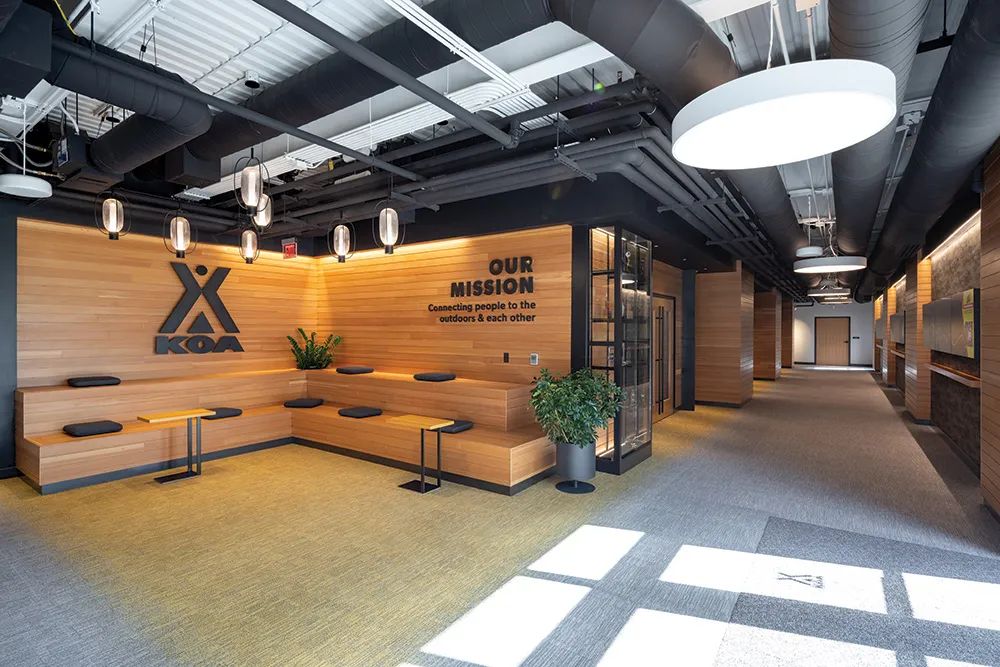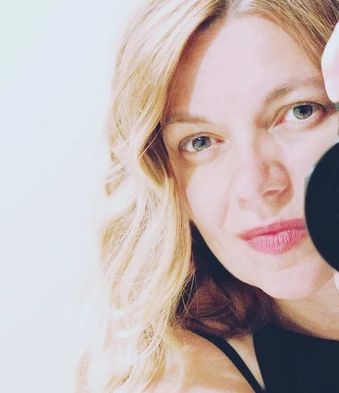
Intentional, Innovative Design: KOA's New Headquarters
October 1, 2024
Article by Jessica Renstrom and photo by Nathan Satran
There is something magical about camping: disconnecting from the daily routine, counting stars in the peaceful night sky, and breathing in the smell of the campfire while feasting on s'mores. For over 60 years, KOA has been helping families make memories in the great outdoors while prioritizing eco-friendly ways to care for it. This Billings, Montana-based business got its start near the Yellowstone River when Dave Drum, a Billings businessman, opened the first campground site on his land in 1962 to accommodate people traveling to the Seattle World’s Fair. Since then, Kampgrounds of America, Inc., known to most as KOA, has grown to over 500 campgrounds.
The addition of its new corporate headquarters situated on Transtech Way in Billings has come out of the company's continual growth. The impressive 35,000 sq ft building is LEED Version 4 Certified Gold and a testament to the company’s commitment to sustainability, the environment, and the individuals working within the building and surrounding community.
Breaking Ground
The KOA corporate office was previously located in downtown Billings. Despite the growing size of its operation, KOA staff continued to work diligently in cramped quarters as the dream for a new location inched closer to becoming a reality. KOA purchased the land for their new building in 2020. The team persevered and broke ground in February 2022 despite COVID disrupting the initial building plans. The vision for the building began to take shape with the help of KOA’s local building partners, including A+E Design, Langlas & Associates, and Peterson Office Supply.
From the beginning of the planning and construction of the new space, KOA has desired the building to model its commitment to sustainability. Environmentally friendly choices were made in the hopes that the building would achieve LEED Certification. “We could have cut corners or budgets and not be a sustainable building, but it’s really important to who we are and what we do. Going that extra mile to be LEED-certified was really important,” states Stacey Campbell, Director of Campground Design Services. With a passion for creating sustainable design, Stacey has been instrumental in honing the vision for the building and implementing the features that would be considered during the LEED Certification process.
LEED (Leadership in Energy and Environmental Design) is the most widely used green building rating system worldwide. “LEED is a holistic system that doesn’t simply focus on one building element, such as energy, water, or health. Instead, it looks at the big picture, factoring in all critical elements that work together to create the best building possible,” states the U.S. Green Building Council’s website. KOA’s goal was to achieve LEED certification with their new building; however, they were elated when they were notified the building had achieved LEED Version 4 Certified Gold.
Intentional, Innovative Design
Several design choices contributing to the building’s LEED Certification can be seen before entering the building. Bike racks and EV chargers encourage visitors to use alternative modes of transportation, while parking has been minimized and landscaped as much as possible to avoid the “heat island” effect. “The landscape is not mowed and pristinely taken care of – it’s all planned that way,” explains Stacey. “It’s all native trees, plants, and wildflowers. We water it now to establish it, but within a year’s time, we can pretty much turn the sprinklers off.” The area is certified as a wildlife habitat, and staff have already seen wildlife within the environment KOA has worked to preserve.
A plethora of environmentally-friendly materials and energy-saving enhancements have contributed to its LEED Certification. Some of these include the use of low-VOC paint and adhesives to increase indoor environmental air quality, LED lights and occupancy sensors to conserve energy, and water-efficient restroom features to reduce the amount of water used.
Functionality is also a high priority, as seen in the downstairs conference areas, which feature movable walls and can accommodate up to 120 people. These areas are open to the community and have already been used to host meetings with the Chamber of Commerce and ZooMontana.
Bringing the Outdoors In
In addition to prioritizing environmentally-friendly design, it was incredibly important to KOA CEO Toby O'Rourke that the company’s mission, “Connecting people to the outdoors and others,” was not only visible throughout the building but also felt by the people within it.
“Toby challenged our architectural and design team to make sure that our staff had opportunities to connect to the outdoors,” explains Stacey. The building accomplishes this in many ways, including strategically placing all offices on the perimeter of the building to ensure plenty of sunlight and installing working windows to let in fresh air. There are also literal examples in which the outdoors is brought into the space, with the addition of stones and plants infused into the design. “There’s a lot of ways with lighting, views, and materials that really we tried to incorporate and feel that connection to the outdoors,” states Stacey.
Visual Displays & Indigenous Artwork
In addition to outdoor views, KOA staff and visitors can enjoy captivating Indigenous artwork throughout the building curated by Agnes Hsu-Tang, a world-renowned archeologist, art historian, and activist, and the wife of KOA owner Oscar Tang.
Within a few moments of entering the lobby, you can find a variety of intriguing artwork, including a piece by Randy Lee White entitled Turns To, a portrait of KOA owner Oscar Tang painted by Ben Pease; Earl Biss’s Ritual Dance of the Moon Hunters, which hangs above the fireplace; and a piece entitled Crow Camp at Turtle Creek created by Native American painter Kevin Red Star. Several of Kevin Red Star’s pieces can be found throughout the building, as well as pieces from talented Western artists such as Fritz Scholder, Lee Marmon, Sheldon Harvey, Judd Thompson, Harry Fonseca, Ed Singer, Frank Big Bear, David Bradley, and Bill Drum, the brother of Dave Drum, KOA’s founder.
Also in the lobby is a gorgeous aspen chandelier, created by Jason McGimpsey with A&E Design. The chandelier is yet another example of bringing the outdoors in, as the fixture consists of logs that were sourced from the exact location where the headquarters now sits.
In addition to the chandelier, Jason McGimpsey created a clever 3-dimensional display found in multiple places within the building – a wall-size climbing rope feature presenting KOA’s familiar logo in its iconic yellow & red. This brightly colored artistic rendering showcases the logo that has not been altered from its original design, crafted by Billings artist Karlo Fujiwara in the 1960s.
The Future of KOA
As KOA celebrates its 60th year as a Franchise, the Billings-based corporation is grateful for its new space and eager to continue its mission.
“As we are growing, building, and redesigning campgrounds, sustainability is a key aspect that Stacey and her team keep in mind,” mentions Jenny McCullough, KOA’s Senior Director of Brand Growth.
KOA continues to act on its commitment to preserving the environment by developing its Kamp Green program. The program encourages KOA owners & visitors to adopt eco-friendly practices and grants certifications to campgrounds that are making adjustments to become more “green.”
KOA’s newest glamping venture, Terramor Outdoor Resort, launched in Maine, was also designed with sustainability in mind and a goal to be SITES-certified. SITES, a rating system for outdoor spaces similar to LEED, aims to protect ecosystems. Terramor was recently awarded the SITES Gold certification, establishing it as the first campground / outdoor resort to earn this designation.
Originally printed in the October 2024 issue of Simply Local Magazine
Check this article out in the digital issue of Simply Local here!





